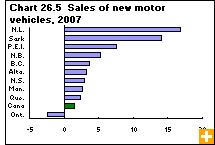Common menu bar links
Motor vehicle sales shifting, not stalled
The auto industry is in a state of flux with rising energy prices and concerns about climate change. Still, Canadians’ vehicle buying patterns in 2007 may not seem consistent with those concerns.
The truck category—including minivans, sport-utility vehicles, light and heavy trucks, vans and buses—posted record-setting sales in 2007. Units sold were at an all-time high of 831,535 units, up 3.5% from 2006.
Overall, dealers sold 1.7 million new vehicles in 2007, a 1.5% increase over 2006 and the second-highest number sold since record-keeping began in 1946.
Newfoundland and Labrador saw the largest growth for new vehicles sold in 2007, at 16.8%. Alberta, which had held the number one spot for sales growth since 2003, posted unit sales percentage growth of 3.3%.
The types of vehicles Canadians are buying have changed in the past decade or so. For example, cars accounted for 65% of sales in 1992, but made up half of 2007 purchases. The 859,003 cars sold in 2007 were 0.5% fewer than in 2006.
This decline continued to come at the expense of the traditional Big Three North-American automakers—General Motors, Ford and Chrysler. In 2007, these automakers accounted for 49.1% of sales, compared with 67.9% in 2000.
Despite the increased sales, the $53.6 billion that Canadian households and business spent on new vehicles in 2007 represented a slight decline (0.6%) from the previous year.
For the first time since 2001, the average amount spent on a new vehicle in Canada fell from the previous year, down 2.0% from $32,386 in 2006 to $31,723 in 2007.


